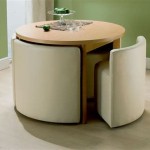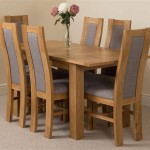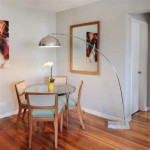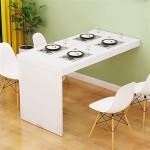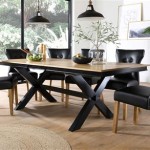Glass Top For A Dining Table: A Comprehensive Overview
A glass top for a dining table presents a sophisticated and versatile option for homeowners seeking to enhance the aesthetic appeal and functionality of their dining space. This article delves into the various aspects of glass dining table tops, exploring their benefits, considerations for selection, different types of glass, maintenance guidelines, and common challenges.
Aesthetic Advantages and Design Versatility
The primary appeal of a glass dining table top lies in its aesthetic qualities. Glass exudes a sense of modern elegance and sophistication, seamlessly blending with diverse interior design styles ranging from minimalist to contemporary and even traditional. The transparency of glass allows the table base, whether it's crafted from wood, metal, or a more unique material, to remain visible, contributing to the overall design scheme. This transparency also creates an illusion of spaciousness, making a room feel larger and brighter, especially beneficial in smaller dining areas.
Beyond simply enhancing the visual appeal, glass tabletops offer considerable design versatility. They can be customized in various shapes, including round, square, rectangular, and oval, to perfectly fit the dimensions and layout of the dining room. The edges of the glass can also be treated in different ways, such as beveled, rounded, or flat polished, further customizing the table's appearance. Furthermore, glass can be tinted or frosted to achieve different effects, adding privacy or creating a more subtle and diffused light reflection.
The compatibility of glass with a multitude of base materials is another key advantage. Wood bases provide a warm and natural contrast, metal bases offer a sleek and industrial aesthetic, while stone or acrylic bases create a more sculptural and artistic statement. This flexibility allows homeowners to create a truly unique and personalized dining table that reflects their individual taste and style.
Factors to Consider When Selecting a Glass Table Top
Choosing the right glass top for a dining table involves careful consideration of several factors. The thickness of the glass is crucial for ensuring its durability and safety. Generally, thicker glass is more resistant to impact and breakage. For dining tables, a minimum thickness of ½ inch (12mm) is recommended, especially for larger tables or those expected to bear heavy loads. Thicker options, such as ¾ inch or 1 inch, offer even greater stability and a more substantial feel. Consider the size and weight of the base when selecting glass thickness. A flimsy base will increase the risk of breakage.
The type of glass is another important consideration. Tempered glass, also known as safety glass, is the most common choice for dining tables due to its superior strength and safety features. Tempered glass is treated with heat to increase its resistance to breakage. If it does break, it shatters into small, blunt pieces instead of sharp shards, significantly reducing the risk of injury. Annealed glass, on the other hand, is not heat-treated and breaks into sharp, dangerous fragments. Therefore, annealed glass is generally not recommended for dining tables.
The shape and size of the glass top should be proportionate to the dining room and the number of people it is intended to accommodate. A round table promotes conversation and intimacy, while a rectangular table is more suitable for larger gatherings. The size of the table should also allow sufficient space for each diner without overcrowding the area. Consider also the weight capacity of the table base in relation to the size and thickness of the glass top.
Finally, the edge treatment of the glass should be carefully considered. Beveled edges add a touch of elegance and sophistication, while rounded edges offer a softer and more contemporary look. Flat polished edges provide a clean and minimalist aesthetic. The edge treatment also affects the safety of the table, as rounded or beveled edges are less likely to cause injury than sharp, unfinished edges. The desired aesthetic needs to be weighed against the practical safety concern of the edges.
Different Types of Glass Used in Dining Tables
While tempered glass is the most prevalent choice for dining table tops, several other types of glass can be used, each with its unique properties and characteristics. Low-iron glass, also known as ultra-clear glass, offers exceptional clarity and transparency, allowing colors to be viewed without any distortion. It is ideal for showcasing intricate table bases or for creating a minimalist look where the glass virtually disappears.
Frosted glass, also known as etched glass, has a textured surface that obscures the view through the glass, providing privacy and diffusing light. It can be used to create a more intimate and subtle dining experience. Frosted glass can also be patterned or decorated to add visual interest.
Tinted glass is available in various colors, such as bronze, gray, or black, adding a touch of drama and sophistication to the dining room. Tinted glass can also reduce glare and heat gain, making it a practical choice for rooms with large windows. Consider the overall color scheme of the room when selecting a tinted glass top.
Textured glass features a raised or embossed pattern on the surface, adding tactile and visual interest. Textured glass can be used to create a unique and artistic look. The textures can range from subtle ripples to more elaborate designs.
Laminated glass, composed of two or more layers of glass bonded together with a layer of plastic interlayer, offers enhanced safety and security. If laminated glass breaks, the fragments remain adhered to the interlayer, preventing them from scattering. This type of glass is often used in public spaces and high-traffic areas.
Maintenance and Care of Glass Table Tops
Maintaining a glass dining table top is relatively straightforward, but it requires regular cleaning and care to prevent scratches, streaks, and stains. Regular cleaning with a soft cloth and a glass cleaner is essential to remove dust, fingerprints, and food residue. Avoid using abrasive cleaners or scouring pads, as these can scratch the glass surface.
Spills should be cleaned up immediately to prevent staining. Acidic substances like vinegar or lemon juice can etch the glass if left on for extended periods. Use coasters and placemats to protect the glass from heat, scratches, and spills. Hot dishes and sharp objects can damage the surface of the glass.
For stubborn stains or streaks, a mixture of water and vinegar can be used. Apply the mixture to the affected area, let it sit for a few minutes, and then wipe clean with a soft cloth. For more severe stains, professional glass cleaning services may be required.
To prevent scratches, avoid placing heavy or abrasive objects directly on the glass surface. Use felt pads or protectors under decorative items or serving dishes. Regularly inspect the table for chips or cracks. Small chips can often be repaired by a professional glass repair service. However, larger cracks may require replacing the entire glass top.
Common Challenges and Solutions
While glass dining table tops offer numerous advantages, they also present some common challenges. Fingerprints and smudges are highly visible on glass surfaces, requiring frequent cleaning to maintain a pristine appearance. Using a microfiber cloth and a high-quality glass cleaner can minimize streaking and smudging.
Scratches are another concern, especially with daily use. While minor scratches can be minimized with scratch repair kits, deeper scratches may require professional polishing or replacement. Taking preventative measures, such as using placemats and avoiding abrasive cleaners, can help prevent scratches.
The coldness of glass can be a deterrent for some users, especially in colder climates. Using placemats, table runners, or other decorative elements can help to add warmth and texture to the table. Alternatively, heated table pads can be used to warm the surface of the glass.
The transparency of glass can also be perceived as a disadvantage by some, as it can reveal the clutter or imperfections underneath the table. Keeping the area underneath the table tidy and organized is essential. Using a decorative tablecloth or runner can also obscure the view underneath the table.

Diy Glasstop Dining Table Tutorial House Of Jade Interiors

Rectangular Glass Top Dining Table 2061 By Esf Furniture Mig

Glass Top Dining Table Bring Luxury And Functionality To Your Mealtimes With A Stunning Centrepiece Hindustan Times

Saloom Furniture Serpent Dining Table Glass Top 2modern

Oval Dining Table In Wood With Glass Top Idfdesign

Furniture Of America Jasmin Glass Top Round Dining Table With Black Base Parks Home Furnishings

Glass Top Tables Magnifying Beautiful Dining Room Design

Cayman Glass Top Dining Table With Timber Legs

Base For Glass Dining Cheap Table

Wooden Glass Top Dining Table Furniture Mart


